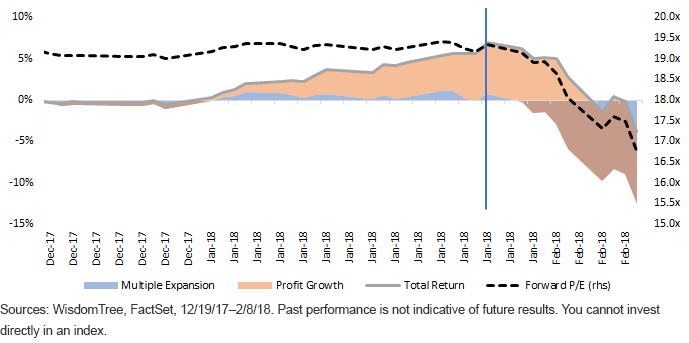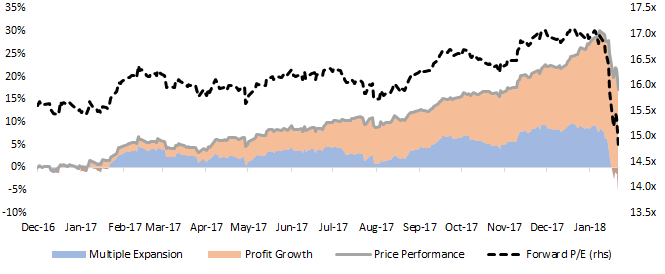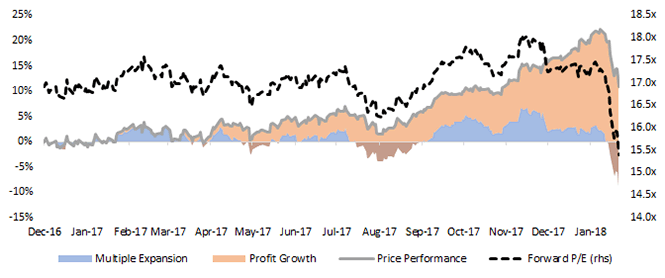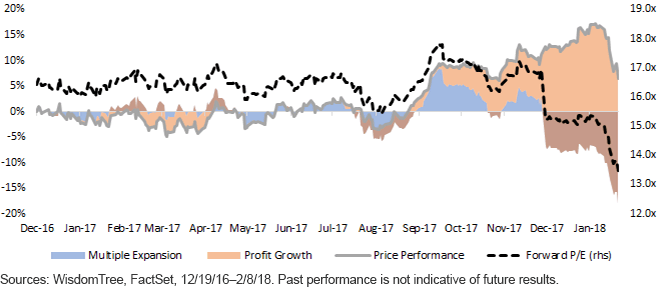U.S. Valuation Watch: More Than a Price Story


Throughout 2017, a common theme at the forefront of many discussions about equity markets in the United States were the high valuations relative to history. It seems, however, that many of the discussions put a great emphasis on the numerator of metrics such as forward price-to-earnings ratio, i.e., the price, rather than giving at least equal consideration to the denominator underpinning the ratio, namely the earnings.
Price Masking Greater Earnings Expectations
Perhaps one of the main reasons investors focus so much on the numerator is because it is immediate; it is what we see on TV and on our screens all day long. However, it does not tell the whole story and can often distract us from what is going on under the hood. For instance, despite the S&P 500 Index returning 7.8% between the passage of tax reform on December 19, 2017, and the all-time high on January 26, 2018, there was indeed little multiple expansion in terms of forward P/E ratios.
S&P 500 Index Profit Growth & Multiple Expansion

Implications of Tax Reform on EPS Estimates
As companies have continued to report their Q4 2017 earnings throughout January and into February, we have seen earnings estimates pick up significantly. A large part of this pickup in earnings estimates is attributable to the positive impact a lower corporate tax rate will have on the profitability of the market constituents. As a result, the denominator of the forward P/E has expanded, thus contracting the overall ratio.
Moreover, during the correction, we saw dramatic forward P/E contraction, while the increases in growth expectations and profitability remained elevated (shown in orange). The result of the drop in prices combined with the boost in earnings expectations is what led to the forward P/E contraction being as substantial as it was.
The Right Tools for Valuation Management
As many investors familiar with WisdomTree may know, not all strategies are created equal. When it comes to valuation sensitivity, the WisdomTree earnings-weighted equity strategies are at the forefront of our toolkit.
Annual Rebalance: Through yearly rebalancing and weighting by core earnings, the WisdomTree earnings strategies maintain a disciplined, fundamentally anchored approach to investing.
Purge the Negative Earners: By utilizing core earnings, these strategies remove unprofitable companies. This tends to result in significant valuation discounts versus the broad market—particularly in the small- and mid-cap segments.
WT U.S. Earnings 500 Index Profit Growth & Multiple Expansion

WT U.S. MidCap Earnings Index Profit Growth & Multiple Expansion

WT U.S. SmallCap Earnings Index Profit Growth & Multiple Expansion

The charts above seek to show the valuation trip, so to speak, that the WisdomTree U.S. Earnings 500 Index, WisdomTree U.S. MidCap Earnings Index, and WisdomTree U.S. SmallCap Earnings Index have taken since their 2016 rebalance went into effect on December 19, 2016.
We first note the pronounced effect of the 2017 rebalance on both the MidCap and SmallCap Earnings Indexes as one of the features of this fundamentally weighted approach. Additionally, both strategies have experienced significant forward P/E contraction related to the aforementioned tax and correction effects.
While many investors may be preoccupied with the timing of the correction and whether to “buy the dip,” this analysis shows that the underlying fundamentals continue to improve irrespective of how the top line may be behaving.

